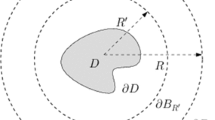Abstract
We deal with the problem of the linearized and isotropic elastic inverse scattering by interfaces. We prove that the scattered p-parts or s-parts of the far field pattern, corresponding to all the incident plane waves of pressure or shear types, uniquely determine the obstacle geometry for both the penetrable and impenetrable obstacles. In addition, we state a reconstruction procedure. In the analysis, we assume only the Lipschitz regularity of the interfaces and, for the penetrable case, the Lamé coefficients to be measurable and bounded, inside the obstacles, with the usual jumps across these interfaces.
Similar content being viewed by others
Notes
The reason why we sum up is explained in the proof of Lemma 2 and the comment in footnote 2.
We need to sum up all the terms to derive the lower bound in terms of |x−y| only.
References
Alves, C.J.S., Kress, R.: On the far-field operator in elastic obstacle scattering. IMA J. Appl. Math. 67(1), 1–21 (2002)
Arens, T.: Linear sampling methods for 2D inverse elastic wave scattering. Inverse Probl. 17(5), 1445–1464 (2001)
Charalambopoulos, A.: On the interior transmission problem in nondissipative, inhomogeneous, anisotropic elasticity. J. Elast. 67(2), 149–170 (2003)
Charalambopoulos, A., Gintides, D., Kiriaki, K.: The linear sampling method for the transmission problem in three-dimensional linear elasticity. Inverse Probl. 18(3), 547–558 (2002)
Charalambopoulos, A., Gintides, D., Kiriaki, K.: The linear sampling method for non-absorbing penetrable elastic bodies. Inverse Probl. 19(3), 549–561 (2003)
Colton, D., Kress, R.: On the denseness of Herglotz wave functions and electromagnetic Herglotz pairs in Sobolev spaces. Math. Methods Appl. Sci. 24(16), 1289–1303 (2001)
Dahlberg, B.E.J., Kenig, C.E.: L p estimates for the three-dimensional systems of elastostatics on Lipschitz domains. In: Analysis and Partial Differential Equations. Lecture Notes in Pure and Appl. Math., vol. 122, pp. 621–634. Dekker, New York (1990)
Gintides, D., Kiriaki, K.: The far-field equations in linear elasticity—an inversion scheme. Z. Angew. Math. Mech. 81(5), 305–316 (2001)
Gintides, D., Sini, M.: Identification of obstacles using only the scattered P-waves or the scattered S-waves. Inverse Probl. Imaging 6(1), 39–55 (2012)
Hähner, P., Hsiao, G.C.: Uniqueness theorems in inverse obstacle scattering of elastic waves. Inverse Probl. 9(5), 525–534 (1993)
Hu, G., Kirsch, A., Sini, M.: Some inverse problems arising from elastic scattering by rigid obstacles. Inverse Probl. 29(1), 015009 (2013), 21 pp.
Ikehata, M.: Reconstruction of the shape of the inclusion by boundary measurements. Commun. Partial Differ. Equ. 23(7–8), 1459–1474 (1998)
Kar, M., Sini, M.: Reconstruction of interfaces from the elastic farfield measurements using CGO solutions. arXiv:1311.4137
Kupradze, V.D.: Potential Methods in the Theory of Elasticity. Israel Program for Scientific Translations, Jerusalem (1965). Translated from the Russian by H. Gutfreund. Translation edited by I. Meroz
Kupradze, V.D., Gegelia, T.G., Basheleĭshvili, M.O., Burchuladze, T.V.: Three-Dimensional Problems of the Mathematical Theory of Elasticity and Thermoelasticity. North-Holland Series in Applied Mathematics and Mechanics, vol. 25. North-Holland, Amsterdam (1979). Edited by V. D. Kupradze, russian edition.
Mayboroda, S., Mitrea, M.: The Poisson problem for the Lamé system on low-dimensional Lipschitz domains. In: Integral Methods in Science and Engineering, pp. 137–160. Birkhäuser, Boston (2006)
Potthast, R.: Point Sources and Multipoles in Inverse Scattering Theory. Chapman & Hall/CRC Research Notes in Mathematics, vol. 427. Chapman & Hall/CRC, Boca Raton (2001)
Potthast, R.: A survey on sampling and probe methods for inverse problems. Inverse Probl. 22(2), R1–R47 (2006)
Author information
Authors and Affiliations
Corresponding author
Additional information
M. Kar supported by the Austrian Science Fund (FWF): P22341-N18. M. Sini partially supported by the Austrian Science Fund (FWF): P22341-N18.
Appendix
Appendix
1.1 A.1 Derivatives of the Helmholtz Fundamental Solution
We have, for \(x,y\in\mathbb{R}^{3}\) with x≠y
1st Order Partial Derivatives
The first partial derivatives of G p can be written as:
for all l=1,2,3.
2nd Order Partial Derivatives
For all l=1,2,3
For l≠m with l,m=1,2,3, we have
3rd Order Partial Derivatives
For all l=1,2,3
For l≠m with l,m=1,2,3 we have
At last for k≠l≠m with k,l,m=1,2,3 we have
1.2 A.2 Derivatives of the Elastic Fundamental Tensor
In (2.3), the fundamental tensor of the elastic model is given. Now the ij-th element of the fundamental tensor Φ(x,y) can be viewed as:
where \(x,y \in\mathbb{R}^{3}\) with x≠y, see for more details ([15], Chap. 2).
For l≠i,j
Similarly, for l=i
and for l=j we obtain
Rights and permissions
About this article
Cite this article
Kar, M., Sini, M. On the Inverse Elastic Scattering by Interfaces Using One Type of Scattered Waves. J Elast 118, 15–38 (2015). https://doi.org/10.1007/s10659-014-9474-5
Received:
Published:
Issue Date:
DOI: https://doi.org/10.1007/s10659-014-9474-5



